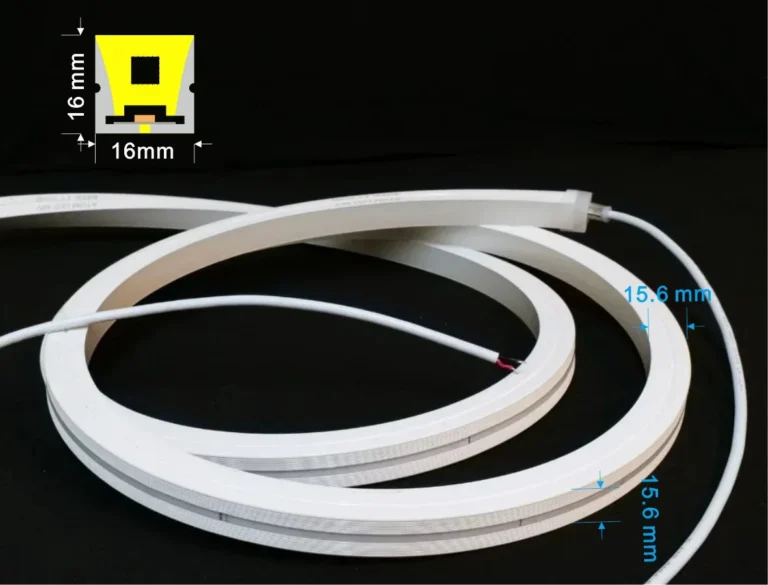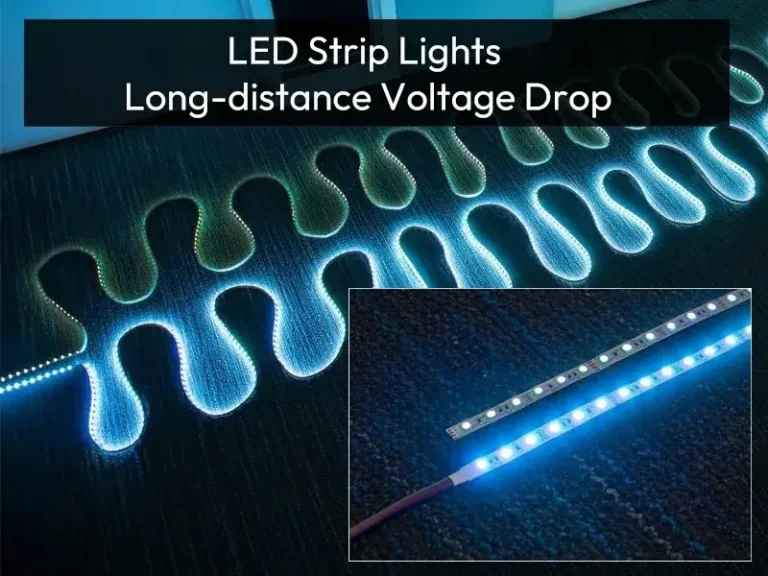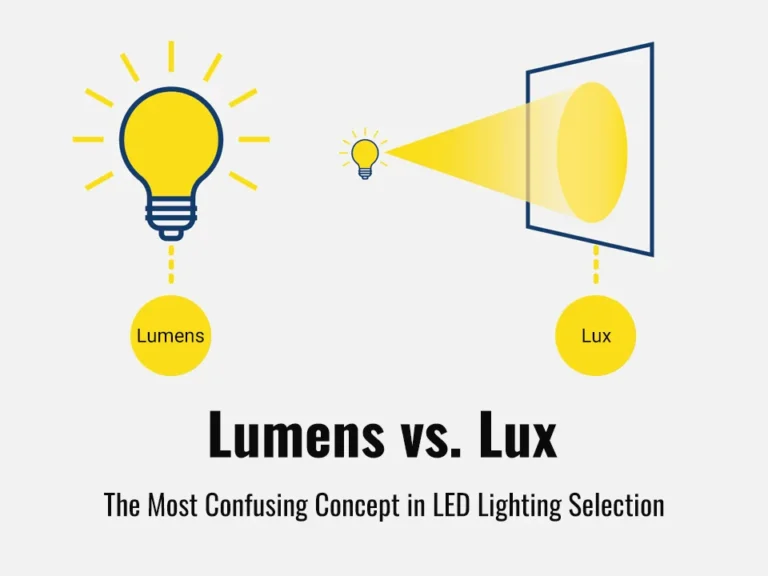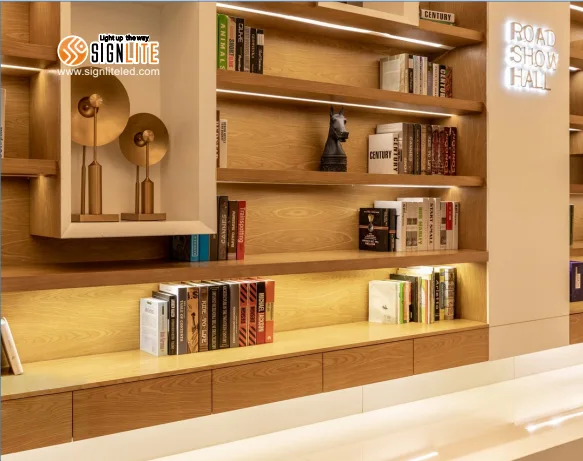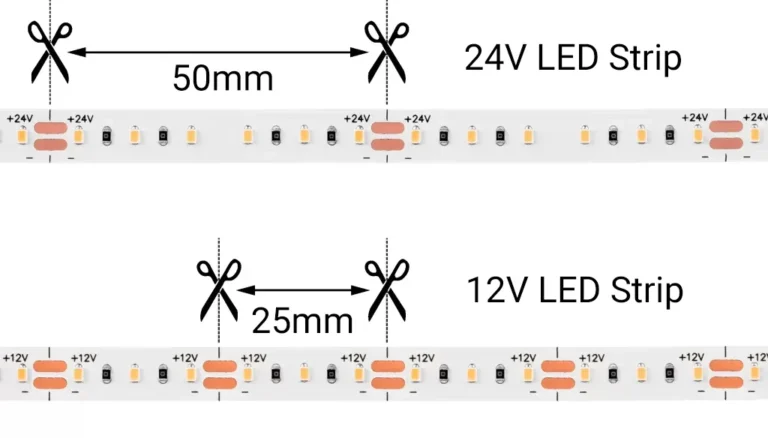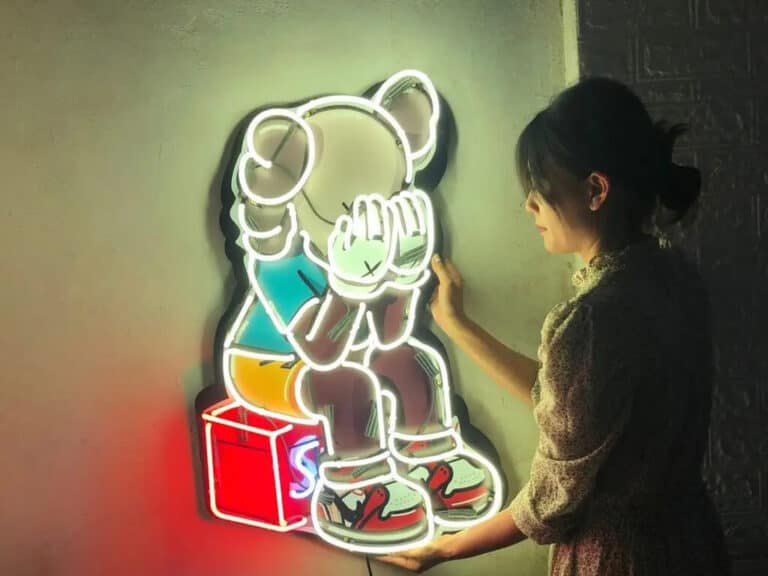실제 조명 프로젝트, 모델 룸 구성 또는 현장 설치에서 12V LED 스트립이 일관성 없는 전원 구성으로 인해 24V 전원 공급 장치에 연결되는 것은 드문 일이 아닙니다. 이것은 단순한 "전압 불일치"처럼 보일 수 있지만, LED 불, 과열 및 흡연, 제품 고장, 심지어 프로젝트 지연과 같은 심각한 문제로 이어질 수 있습니다.
LED 스트립 통합업체, 건축 조명 계약자 및 도매 구매자에게 전체 시스템을 교체하지 않고 기술적 대안 솔루션을 찾는 것이 중요해졌습니다.
이 기사는 다음과 같이 체계적으로 분석합니다.
- 전압 불일치의 작동 원리와 위험
- 24V 시스템에서 12V LED 스트립의 응용 프로그램 제한 사항
- 실현 가능한 전압 감소 및 절연 솔루션
- 프로젝트 시나리오를 기반으로 안전한 전원 공급 장치 설계를 선택하는 방법
안정적이고 비용 효율적인 솔루션을 찾고 있다면 이 기사는 마지막에 권장되는 LED 스트립 제품과 기술 지원 제안도 제공합니다.
12V LED 스트립을 24V 전원 공급 장치와 직접 사용할 수 없는 이유는 무엇입니까?
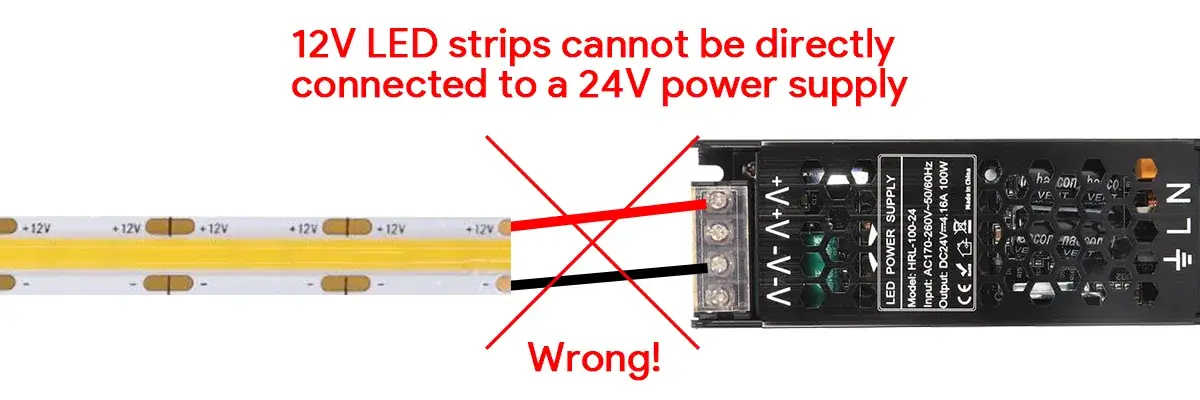
LED 조명 프로젝트에서 12V와 24V는 가장 일반적인 두 가지 저전압 표준입니다. 비록 ...일지 12V 및 24V LED 스트립 구조가 비슷하게 나타나며 내부 회로 설계, 저항 분포 및 전류 전달 용량이 완전히 다릅니다. 12V 스트립을 24V 전원에 연결하면 전압 과부하가 직접 발생하여 다음과 같은 심각한 결과가 발생합니다.
과도한 전압의 결과
12V 스트립은 12V의 전압에서 작동하며, 24V DC 전원에 연결하면 정격 전압의 두 배가 되어 한계를 초과합니다. 일반적인 문제는 다음과 같습니다.
- LED 칩의 즉각적인 소진: LED 칩은 12V 전류에서 작동하도록 설계되었습니다. 24V에 연결하면 전류가 두 배로 증가하여 심각한 과열을 유발하여 LED 칩 소진 또는 변색을 유발할 수 있습니다.
- 저항 과열 손상: LED 스트립의 직렬 연결 전류 제한 저항이 심하게 과열되어 잠재적으로 저항기 고장, PCB 변형 또는 연기 또는 화재 위험을 유발할 수 있습니다.
- 전체 라이트 스트립을 사용할 수 없게 됨: 회로가 손상되면 수리 비용이 특히 어려운 설치 시나리오에서 전체 라이트 스트립을 교체하는 비용을 초과합니다.
LED 번아웃의 원리 분석
LED는 근본적으로 전류 구동 장치이며 전압의 변화로 인해 전류가 급격히 상승할 수 있습니다. 일반적으로 12V 라이트 스트립은 직렬로 연결된 3개의 LED로 구성되며, 그 다음에는 전류 제한 저항이 있는 병렬로, 일정한 밝기를 유지합니다. 24V에 연결하면 제어되지 않는 전류가 다음과 같은 현상을 일으킵니다.
- 직렬 연결 LED는 전류 공유 보호를 잃습니다. 하나의 LED가 타면 전체 그룹이 작동을 멈춘다.
- 저항이 과열되어 보드 표면이 탄화됩니다.
- 양극 단자 과전압 파괴는 회로에 단락을 일으킵니다.
현장 사용 위험은 실험실 환경보다 훨씬 높습니다.
실험실 환경에서 단시간 동안 24 V에 연결해도 라이트 스트립이 즉시 소모되지 않더라도 다음 엔지니어링 시나리오에서 위험이 크게 증가합니다.
- 대량 병렬 설치: 전력 부하가 증가하고, 한 부분이 고장나면 연쇄 반응이 쉽게 발동됩니다.
- 야외 또는 밀폐 알루미늄 채널 환경: 열이 잘 나가지 않아 열이 빠진다.
- 라이트 스트립의 숨겨진 설치: 번아웃이 늦게 감지되어 유지 보수 비용이 많이 듭니다.
전압 불일치는 "사소한 문제"가 아니라 라이트 스트립의 수명, 안전 및 프로젝트 배송 일정에 심각한 영향을 미치는 심각한 위험입니다. 신뢰성을 우선시하는 모든 상업용 조명 프로젝트의 경우 12V 라이트 스트립이 24V 전원 공급 장치에 연결되는 것을 방지하는 것은 가장 기본적인 전기 설계 표준 중 하나입니다.
24v 전원 공급 장치에서 12v LED 스트립 조명을 안전하게 실행할 수 있습니까?
기술적으로는 가능하지만 직렬로 올바르게 연결하는 경우에만 가능합니다.
올바른 전압에 대해 지정된 제품과 액세서리를 사용하는 것이 좋습니다. 그러나 12V LED 스트립 조명을 연결하는 방법을 보여 드리겠습니다. 24V 전원 공급 장치 LED 스트립 조명을 손상시키지 않고!
면책 조항: 과전압을 유발하는 부정확하거나 우발적인 연결로 인해 LED가 영구적으로 손상될 수 있습니다. 여기에 제공된 정보는 교육 목적으로만 제공됩니다. Signlited는 손해에 대해 책임을 지지 않습니다.
안전상의 이유로, 더 긴 섹션을 연결하기 전에 모든 것이 올바르게 설정되었는지 확인하기 위해 동일한 12V LED 스트립의 두 개의 짧은 섹션으로 테스트하는 것이 좋습니다.
올바른 배선 방법: 직렬 연결
이론적으로 두 개의 동일한 12V LED 라이트 스트립을 직렬로 연결하면 총 전압이 24V가 되므로 24V 시스템과 호환됩니다. 이러한 방식으로 LED 라이트 스트립을 연결함으로써 24V 전원 공급 장치는 두 개의 LED 라이트 스트립 세그먼트 사이에서 효과적으로 "분할"되며 각 세그먼트는 12V를 수신합니다. 두 개의 LED 라이트 스트립이 직렬로 연결되어 있기 때문에 각 LED 라이트 스트립은 동일한 전류를 소비합니다. 구체적인 연결 방법은 아래 그림을 참조하십시오.

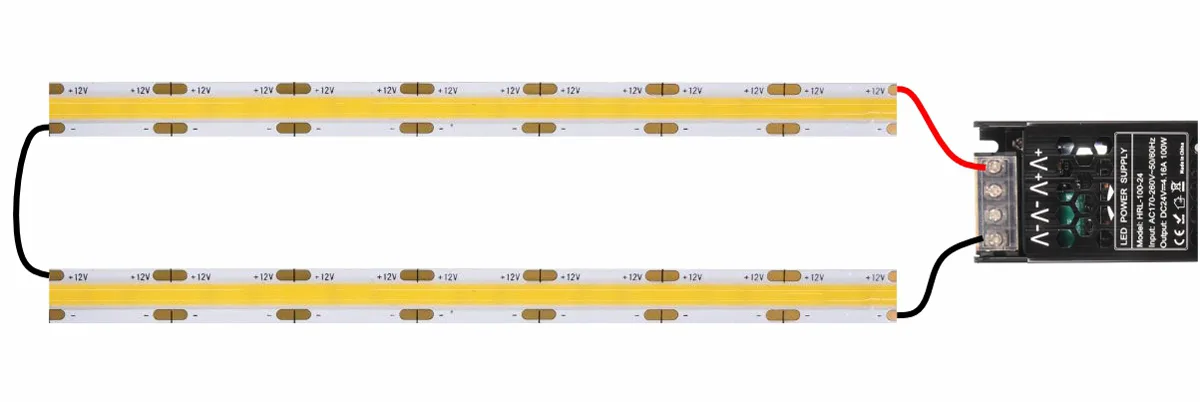
경고: 직렬로 연결된 두 개의 LED 라이트 스트립은 정확히 동일해야 합니다!
이것이 왜 그렇게 중요한가?
서로 다른 길이의 12V LED 라이트 스트립이 직렬로 연결되어 있다고 가정합니다. 12V 전압에서 각각 0.5A 및 1.0A의 전류를 소비합니다. 직렬로 연결되어 있으므로 동일한 순방향 전류 값을 공유해야 합니다. 현재 값이 정확히 0.75A(중간점)라고 가정합니다.
더 긴 LED 라이트 스트립의 경우 0.75A(정격 1.0A가 아닌)의 더 낮은 전류와 일치하도록 전압을 11V 또는 10V로 떨어뜨려야 할 수 있습니다. 그러나 이름에서 알 수 있듯이 24V 정전압 입력은 24V에서 일정하게 유지되므로 더 짧은 LED 라이트 스트립은 이제 나머지 13V 또는 14V 전압을 "구성"해야 합니다. 이로 인해 더 짧은 LED 라이트 스트립이 과전류 상태를 경험하고 LED가 손상될 수 있습니다.
직렬 구성에서만 12V LED 라이트 스트립이 24V 전원 공급 장치에서 작동할 수 있습니다. 이 기술은 스마트하고 확장 가능하며 교육 및 설치 목적에 매우 유용하지만 실제 엔지니어링 프로젝트 설치에서 상당한 위험을 초래할 수 있습니다.
- 동일한 스트립 길이와 유형을 사용해야 합니다.
- 고르지 않은 전압 분포가 발생할 수 있습니다.
- 한 스트립의 결함은 다른 스트립에 영향을 줄 수 있습니다.
저항의 변화, 일관되지 않은 납땜 또는 스트립의 고르지 않은 노화로 인해 전압 분포가 고르지 않아 손상 위험이 증가할 수 있습니다. 따라서 이 방법은 비상 상황에서만 사용하는 것이 좋습니다!
LED 스트립 조명을 전원 공급 장치에 연결하는 방법에 대한 자세한 내용은 블로그 게시물을 참조하십시오. 전원 공급 장치에 LED 스트립 조명을 배선하는 궁극의 가이드 그리고 LED 스트립 조명을 전원 공급 장치에 연결하는 방법.
더 나은 기술 솔루션: 24V 시스템에서 12V LED 스트립 조명을 사용하는 방법
일부 프로젝트 현장에서는 24V 전원 공급 시스템이 이미 균일하게 배치되었습니다. 그러나 재고 문제, 아웃소싱 또는 이후 단계 요구 사항의 변경으로 인해 12V LED 스트립 조명을 일시적으로 사용해야 할 수도 있습니다. LED 스트립 조명 자체를 교체할 수 없는 경우 24V 전원 공급 장치 시스템에 안전하게 연결할 수 있는 방법이 있습니까? 대답은 예이지만 시스템 안정성과 안전한 작동을 보장하기 위해 전문적인 전압 감소 방법을 사용하여 수행해야 합니다.
해결 방법 1: DC-DC 스텝다운 컨버터 사용
가장 일반적이고 안전한 방법입니다. 전원 공급 장치 출력과 LED 스트립 사이에 DC-DC 스텝다운 컨버터를 삽입함으로써 24V 전압은 12V 출력으로 안정적으로 변환되어 LED 스트립이 정상적으로 작동하도록 합니다.
장점:
- 모든 12V LED 스트립 모델과 호환되는 12V를 정확하게 출력합니다.
- 여러 개의 모듈을 병렬로 연결하여 세그먼트 전원 공급 장치를 연결할 수 있으며 배선을 용이하게 합니다.
- 과전압 보호 및 과부하 보호 기능이 있는 산업용 모듈을 사용하여 시스템 안정성을 향상시킬 수 있습니다.
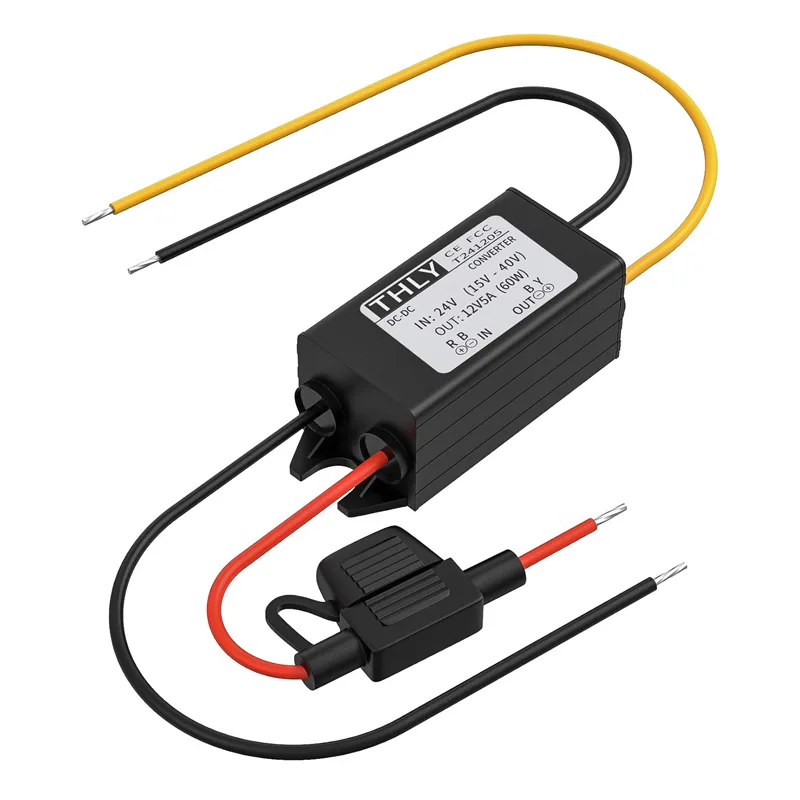
DC24V-12V 강압 컨버터
출력 전압: DC12V
최대 전류: 5A 60W
효율성: 96%
방수: IP67
제품 크기: L114 x W79 x H20 mm
순중량: 264g
애플리케이션 시나리오:
- 쇼핑몰 진열장 및 창 조명;
- 전시 및 전시를 위한 조정 가능한 조명;
- 세분화된 제어 기능이 있는 실내 조명 시스템.
권장 고려 사항:
- 모듈 전력은 라이트 스트립의 총 전력 소비량을 충족해야 하며, 20%-30% 마진을 남기는 것이 좋습니다.
- 단락 보호 및 전압 안정화 기능이 있는 제품을 선호합니다.
- 설치 중 열 발산 및 방수에주의하십시오 (실외 프로젝트에 사용되는 경우).
해결 방법 2: 이중 전원 시스템 구성(절연 전원 공급 장치)
중대형 규모의 프로젝트에서는 24V 주 전원 공급 장치가 24V 장비를 구동하고 12V 전원 공급 장치가 12V 라이트 스트립에 추가되는 이중 전원 공급 시스템도 채택할 수 있습니다.
장점:
- 더 쉬운 유지 보수를 위해 각 시스템의 독립적인 제어;
- 전원 공급 장치 간섭에 민감한 고급 프로젝트에 더 적합합니다.
- DMX, DALI와 같은 지능형 제어 시스템과 함께 배치할 수 있습니다.
적용 가능한 시나리오:
- 호텔, 상업 단지, 박물관 등의 다중 시스템 조명 프로젝트;
- 프로젝트 구현 중에 12V 모듈을 추가할 때 더 쉽게 통합할 수 있습니다.
참고:
- 두 전원 공급 그룹은 공통점을 공유하지 말고 완전히 격리되어야 합니다.
- 구현 중 배선 오류를 방지하려면 회로의 명확한 라벨링이 필요합니다.
- 제어 시스템은 전압 세그먼트에 따라 그룹화되어야 합니다.
해결 방법 3: 중앙 집중식 전원 공급 장치 + 모듈식 출력 설계(통합 시스템에 적합)
분산 조명 제어 시스템(대규모 지능형 조명 플랫폼)의 경우 중앙 집중식 전원 공급 장치 캐비닛을 사용하여 24V 전원을 균일하게 입력한 다음 모듈식 출력 보드를 통해 12V 신호로 변환할 수 있습니다.
장점:
- 중앙 집중식 관리 및 모듈식 설치;
- 산업용 조명 및 지능형 건물 제어 시스템에 적합합니다.
- 유지 보수 비용을 줄이고 결함 진단을 용이하게 합니다.
단점:
- 더 높은 초기 배포 비용;
- 건설 배선에 대한 특정 요구 사항.
권장되지 않는 솔루션: 직렬 연결 라이트 스트립, 저항 전압 감소 등
회로 이론적 관점에서 직렬 저항 또는 다중 직렬 연결을 추가하여 전압 감소를 달성할 수 있으며 이전 장에서 이 솔루션의 연결 및 원리도 자세히 설명했지만 이러한 방법은 실제 조명 프로젝트에서 높은 고장률과 안전 위험을 제시합니다.
- 직렬 연결 LED 라이트 스트립은 구성 요소 균일성에 의해 크게 영향을 받습니다.
- 저항 전압 감소 방법은 비효율적이며 과도한 열을 생성합니다.
- 이 솔루션에는 보호 메커니즘이 없으며 전압 변동으로 인해 장비가 쉽게 손상될 수 있습니다.
따라서 전문적인 프로젝트의 경우 표준화된 전압 감소 모듈 또는 안정적인 출력 및 보호 기능을 갖춘 그룹화된 전원 공급 장치 시스템을 선택하는 것이 필수적입니다.
12V 라이트 스트립이 24V 시스템과 호환되지 않는 문제에 대한 솔루션이 존재하지만 적절한 계획과 표준화된 선택이 필요합니다. 프로젝트 규모, 설치 환경 및 제어 시스템에 따라 적절한 전압 감소 방법을 선택하면 개조 비용을 절감하고 장기적으로 안정적인 시스템 작동을 보장할 수 있습니다.
대체 권장 사항: 호환되는 전압이 있는 LED 스트립 제품 선택
12V LED 스트립이 24V 시스템과 호환되도록 스텝다운 솔루션을 제공하지만, 프로젝트 안전성, 안정성, 유지비용 측면에서 보면 LED 스트립 제품 프로젝트의 시작부터 시스템에 호환되는 전압. 이 전략은 엔지니어링 실패율을 효과적으로 줄이고 전체적인 시스템 효율성을 개선하며 서비스 수명을 연장할 수 있습니다.
따라서 프로젝트를 기반으로 올바른 솔루션을 선택해야 합니다. 24V 시스템에서 12V LED 라이트 스트립을 사용할지 여부를 결정할 때 다음과 같이 자문해 보십시오.
- 이것은 임시 또는 영구적인 설정입니까?
- 강압 컨버터나 추가 전원 공급 장치를 사용할 수 있습니까?
- 안전하게 직렬로 연결할 수 있습니까?
- 24V 파워 스트립으로 업그레이드하는 것이 장기적으로 더 효율적입니까?
가장 실용적인 해결책은 24V LED 라이트 스트립으로 업그레이드하는 것입니다. 시스템이 이미 24V에 대해 표준화되어 있는 경우 업그레이드를 통해 설치 및 전원 관리가 간소화될 수 있습니다. 24V가 12V보다 선호되는 이유는 무엇입니까? 12V 시스템과 비교하여 24V LED 라이트 스트립은 중장거리에서 장거리 설치에서 상당한 이점을 제공합니다.
- 낮은 전압 손실: 동일한 현재 조건에서 24V 시스템의 라인 손실은 12V 시스템의 절반이므로 장거리 배선에 더 적합합니다.
- 단위당 전류가 낮아 시스템이 더 안전해짐: 케이블 과열 및 단락의 위험을 줄입니다.
- 더 긴 단일 세그먼트로 만들 수 있습니다.: 과도한 접합점을 피하여 빛 효율의 일관성을 향상시킵니다.
- Dali 및 DMX와 같은 스마트 조명 시스템과의 호환성 향상: 중앙집중식 전원공급과 디지털 디밍을 더 쉽게 달성할 수 있습니다.
따라서 프로젝트가 이미 24V 전력 시스템인 경우 24V 라이트 스트립을 선택하는 것이 가장 안정적인 옵션입니다.
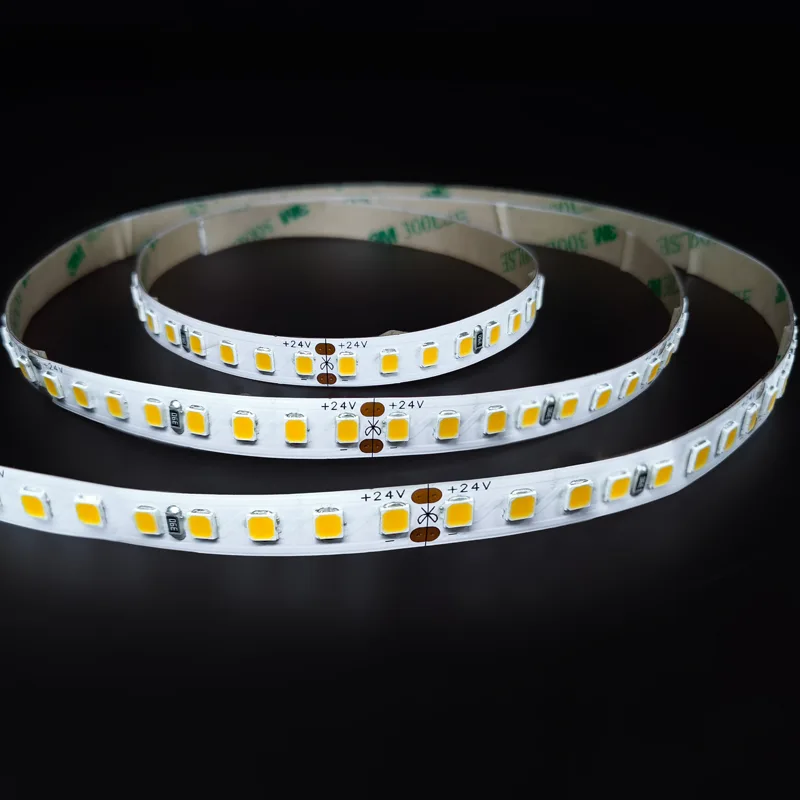
고효율 DC24V LED 스트립 라이트
모델 번호.: FQX10T128C
전압: 직류24V
Power: 12W/m
능률: 190-200lm/W
Ra: >80
CCT: 3000k – 6500k
LED 유형: SMD2835
LED 수량: 128LED/m
PCB 너비: 10mm
절단 단위: 62.5mm/8LED
IP 등급: IP20/IP54/IP65/IP67/IP68
보증: 5년
선택 권장 사항: 프로젝트에 적합한 전압 LED 스트립 선택
| 프로젝트 유형 | 권장 전압 | 추리 |
| 상업 공간 천장 조명 트로프 | 24V | 긴 설치 거리, 중앙 집중식 전원 공급 장치, 최소 라인 손실 |
| 디스플레이 캐비닛 또는 창 조명 | 12V/24V | 라이트 스트립의 길이와 전원 공급 장치 위치에 따라 다름 |
| 스마트 빌딩 디밍 시스템 | 24V | DALI 및 DMX 컨트롤러와 더 호환 |
| 맞춤형 가구 조명 | 12V | 분산 전원 공급 장치, 다양한 길이의 라이트 스트립 및 유연한 배선 |
| 옥외 방수 라이트 스트립 시스템 | 24V | 고전력 드라이버의 안정성 향상 및 전압 저항이 강함 |
올바른 전압을 선택하는 것은 프로젝트의 성공 여부를 결정하는 첫 번째 단계입니다. 건설 후반부에 수정하는 것보다 초기 선택 단계에서 시스템 호환성, 회로 설계 및 제품 성능을 철저히 고려하여 일회성 설치와 장기적인 안정성을 보장하는 것이 좋습니다. 실제 프로젝트 구현에서는 엔지니어링 경험이 있는 공급업체와 협력하여 전압, 전류 요구 사항, 제어 방법 및 설치 환경을 기반으로 시스템을 사용자 정의하는 것이 좋습니다.
24V 또는 12V LED 스트립 선택에 대해 여전히 질문이 있는 경우 SignLiteD에서 다음과 같은 지원을 제공할 수 있습니다.
- 엔지니어링 전원 공급 장치 및 LED 스트립 시스템 매칭 설계;
- DC-DC 벅 모듈 및 중앙 집중식 전원 공급 장치 솔루션;
- 다양한 상업 프로젝트에 적합한 대량 공급 및 OEM 사용자 정의 서비스.
제발 문의하기 프로젝트 평가 및 전문적인 조언을 위해.
요약: 일치하지 않는 12V/24V 시스템과 관련된 위험을 완화하는 방법
상업용 조명 및 엔지니어링 프로젝트에서 LED 스트립 조명 시스템의 안정적인 작동은 제품 자체의 품질뿐만 아니라 전원 공급 시스템의 합리성과 설치 표준 준수에 달려 있습니다. 이 기사에서는 12V LED 스트립을 24V 전원에 직접 연결하는 것이 스트립 손상 및 프로젝트 재작업으로 쉽게 이어질 수 있는 고위험 관행이라는 여러 솔루션과 기술적 분석을 통해 식별합니다.
프로젝트 요구 사항이나 재고 제약으로 인해 24V 시스템에서 12V 스트립을 사용해야 하는 경우 장비 안전과 수명을 보장하기 위해 전문적인 전압 감소 모듈 또는 절연 전력 시스템을 선택해야 합니다.
장기적인 관점에서 볼 때, 프로젝트의 처음부터 전원 공급 장치 시스템 전압과 일치하는 LED 스트립 제품을 선택하는 것은 엔지니어링 복잡성을 줄이고 설치 후 유지 관리를 최소화하기 위한 최적의 전략입니다.
LED 스트립 조명 프로젝트에 대한 전기 표준의 권장 목록
| 프로젝트 단계 | 추천 |
| 도식 설계 단계 | 다중 전압 혼합을 방지하기 위해 시스템 공급 전압(12V 또는 24V)을 지정합니다. |
| 라이트 스트립 제품 선택 | 24V 시스템의 24V 조명 스트립과 같은 시스템과 호환되는 전압 버전 선택 우선 순위 지정 |
| 현장 배선 설치 | 12V 조명 스트립을 24V 전원에 직접 연결하는 것을 엄격히 금지하고 DC-DC 스텝다운 모듈 또는 절연 전원 공급 장치를 사용해야 합니다. |
| 전원 공급 장치 조달 | 단락, 과전압 및 과열 보호 기능이 있는 전원 공급 장치 및 강압 모듈 선택 |
| 라이트 스트립 설치 테스트 | 각 섹션을 설치하기 전에 세그먼트 조명 테스트를 수행하여 전체 회로 전원 켜기 후 결함을 방지합니다. |
| 프로젝트 전달 및 수락 | 전원 공급 장치와 라이트 스트립 모델이 일치하는지 확인하고 전원 공급 장치 다이어그램 및 라이트 스트립 배선 계획을 문서화하십시오. |
프로젝트가 교차 전압 호환성 솔루션, 중앙 집중식 전원 공급 장치 설계 또는 맞춤형 모듈에 필요한 경우, 서명된 팀에 문의하십시오. 우리는 포괄적인 LED 스트립 조명 프로젝트의 효율적인 배송과 안정적인 운영을 위해 시스템 설계 지원을 제공합니다.
자주 묻는 질문
이 작업을 수행하지 않는 것이 좋습니다. 단기간에 타지 않더라도 라이트 스트립의 수명을 크게 단축하고 안전 위험을 초래할 수 있습니다. 일부 가벼운 비드는 고온에서 약간의 변색 또는 밝기가 저하될 수 있으며 위험을 제어하기가 어렵습니다.
이것은 권장되지 않습니다. 전압 공유는 이론적으로 가능하지만, 일관성 없는 임피던스와 저항으로 인해 한 섹션이 먼저 소진되어 다른 섹션이 보호되지 않고 연쇄 반응이 발생할 수 있습니다.
1. 출력 전력이 LED 스트립의 총 전력 소비를 충족하고 마진을 허용하는지 확인하십시오.
2 . 모듈은 단락, 과전압 및 과열 보호 기능을 갖추어야 합니다.
3. 실외 또는 고온 환경에서 방열 또는 방수 조치를 향상시킵니다.
이중 전원 시스템 또는 중앙 집중식 전원 공급 장치 + 모듈식 출력 구성을 사용할 수 있습니다. 핵심은 서로 다른 전압 시스템 간의 물리적 격리, 명확한 배선, 독립적인 제어 및 도면의 명확한 라벨링을 보장하는 것입니다.
라이트 스트립 라벨, 전원 인터페이스 라벨을 확인하거나 멀티미터를 사용하여 작동 전압을 측정합니다. 다른 전압을 혼합하여 잘못된 연결을 방지하기 위해 시공 전에 광 스트립 전압 배치를 관리하는 것이 좋습니다.
